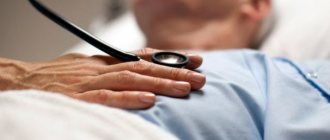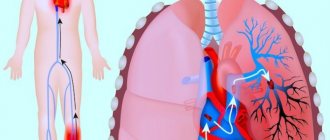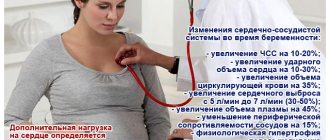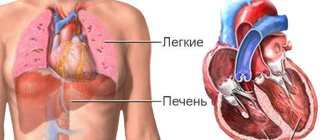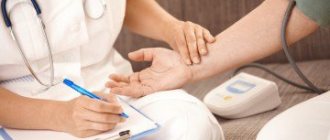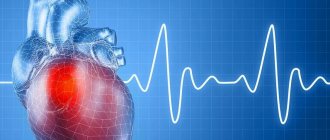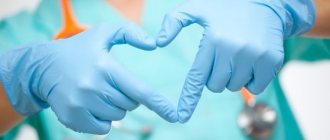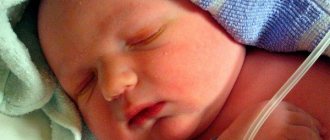The human circulatory system can be compared to a pipeline, and the heart to a pump to ensure the movement of blood. In healthy people, heart contractions occur evenly and with a certain frequency, but sometimes it happens that normal rhythms are disturbed. Such a malfunction can occur not only in adults; arrhythmia in children is a common occurrence.
The functions of the heart are ensured by the coordinated functioning of the heart muscle (myocardium), conductive and autonomic nervous systems. If failures occur at any stage, contraction rhythms may be disrupted, which will lead to the development of arrhythmia.
This disorder can also appear in childhood; moreover, arrhythmia is often diagnosed in children. However, symptoms of rhythm disturbances can also appear outside of heart disease, which is why not all patients need treatment.
Causes of the disease
The etiology of childhood arrhythmia varies. The reasons are divided into the following types:
- extracardiac;
- mixed;
- cardiac.
Arrhythmia in newborns is formed due to prematurity of the fetus, developmental delays, endocrine pathologies, nervous disorders, stress, and VSD in the mother.
Of the mixed reasons, the main ones are:
- psychological instability;
- physical stress;
- change in myocardial structure.
The group of cardiac causes of arrhythmia in adolescents includes:
- heart defects;
- surgical cardiac intervention;
- myocarditis and pericarditis;
- sternum injury with damage to the heart organ;
- myocardial dystrophy;
- heart damage during probe examination.
Children's arrhythmia can develop after complicated infectious and viral diseases. At risk are patients who have had:
- bronchitis;
- acute intestinal infections;
- sore throat;
- sepsis and pneumonia.
Often the nature of the disease can be called functional, the peculiarity of which is that it resolves itself after some time. But even under such circumstances, you need to see a cardiologist and examine the child’s heart.
Clinical case: “The child is 8 years old. The ECG showed sinus arrhythmia. The reason for the surrender was a severe sore throat. After it, we noticed a bluish coloration of the lips and eyelids. There were complaints of shortness of breath.”
Comment from a cardiologist
|
Child's heart rate (from newborn to teenager)
It is possible to determine arrhythmia in its initial manifestations in a child without resorting to the services of a specialist. The fact is that there are heart rate standards that correspond to all ages, from infancy to adolescence, and the older the child, the slower his pulse .
Thus, in infants the normal pulse is at the level of 140 beats per minute, in one-year-old children it decreases to 120, by the age of five it reaches 100, and by ten - 80. In adolescent children, the heart beats with almost the same rhythm as in adults – from 60 to 80 blows.
| Children's age | Heart rate value, beats/min |
| Newborns | 140-160 |
| 6 months | 130-135 |
| 1 year | 120-125 |
| 2 years | 110-115 |
| 3 years | 105-110 |
| 5 years | 100-105 |
| 8 years | 90-100 |
| 10 years | 80-85 |
| 12 years and older | 70-75 |
Symptoms
In 40% of children, an abnormal heartbeat is detected randomly. Pathology is detected during clinical examination or after a preventive examination. Timely detection of arrhythmia in a child or newborn is possible only with systematic examinations.
The disease manifests itself with the following clinical symptoms:
- periodically the skin becomes bluish or too pale;
- shortness of breath appears;
- the patient is lethargic and eats poorly;
- Spontaneous attacks of crying and anxiety occur;
- the child sleeps restlessly at night and wakes up periodically;
- does not gain weight;
- refuses to eat.
In adolescents, moderate arrhythmia goes away for a long time without significant symptoms. Later the following signs will appear:
- regular fainting;
- groundless fatigue;
- physical passivity;
- discomfort in the sternum;
- low pressure;
- increasing weakness.
Young children cannot clearly and timely explain to their parents their painful sensations, so mothers and fathers themselves need to monitor their well-being and activity, and immediately contact a pediatrician at the first symptoms. Self-medication will lead to dire consequences.
Development mechanism
Disorders of contraction rhythms can be caused by the following reasons:
- developmental defects or heart diseases that interfere with the rhythmic contractions of the myocardium;
- various disorders of the nervous system that affect the functions of the heart;
- defects in the operation of the impulse-conducting system.
Thus, the causes of the appearance of rhythms should not in all cases be associated with heart disease. Therefore, it is customary to distinguish two types of arrhythmias occurring in children:
- functional disorders are not associated with heart damage; they are provoked by malfunctions in other systems. With this type of disease, treatment of arrhythmia is not required, it is important to eliminate the provoking factor, and rhythm disturbances will go away on their own;
- organic disorders are provoked by damage to the system responsible for supplying impulses, or to the myocardium itself. These types of arrhythmias can be caused by heart defects or inflammatory diseases. It is organic arrhythmia that is most dangerous, since the disturbances are persistent and have a significant impact on well-being. The patient requires serious and sometimes surgical treatment.
The appearance of arrhythmia in a child is possible at any age. Heart rhythm disturbances can even be congenital. Functional disorders are often detected at the age of 10-15 years, that is, during the most intensive growth.
The most common causes of congenital arrhythmias are:
- pathologies of pregnancy in the mother;
- premature or complicated birth;
- intrauterine hypotrophy, leading to damage to the conduction system;
- congenital hypothyroidism, etc.
Acquired arrhythmias can be caused by the following reasons:
- infectious diseases that cause complications on the heart;
- severe infections that cause electrolyte imbalance;
- vasculitis, rheumatism and other autoimmune diseases.
Classification
There is a division of childhood arrhythmia according to certain characteristics. According to myocardial dysfunction, the classification looks like this:
- automatism;
- excitability;
- conductivity of the first two factors.
With myocardial excitability, the disease can be of the following types:
- extrasystole;
- tachycardia;
- atrial fibrillation.
There is also a classification of impaired myocardial conductivity:
- atrioventricular;
- intraatrial;
- sinoatrial;
- intraventricular.
Various types of arrhythmias
The clinical picture also has two forms - significant and insignificant. In the first case, sinus arrhythmia has a pronounced causative factor and requires complex treatment. In the second case, the diagnosis does not have a pathological component, does not affect health and is limited only by symptoms. Minor symptoms disappear as the patient gets older.
There is a classification of the disease according to its severity:
- light;
- expressed;
- moderate.
The reliable form of pathology is determined by a cardiologist. His responsibilities include prescribing adequate therapy.
Diagnostics
To establish the etiology of sinus arrhythmia in children, specialists carry out a thorough diagnosis, consisting of the following measures:
- initial examination of the patient, which is carried out in the presence of parents;
- collection and analysis of family and individual history;
- definition of a set of symptoms.
You should also undergo instrumental diagnostic methods:
- cardiogram;
- echocardiography;
- monitoring heart rate throughout the day;
- electroencephalogram;
- X-ray of the spine in the neck area;
- pharmacological tests.
Monitoring - daily monitoring of heart rhythm
In case of urgent need, the doctor prescribes laboratory tests. This type of diagnosis in this case does not provide any valuable information, therefore it is prescribed at the discretion of the cardiologist or pediatrician.
To determine the etiology of respiratory arrhythmia, an additional consultation with a neurologist is sometimes required.
What is called arrhythmia?
The collective term arrhythmia in childhood refers to a group of cardiac pathologies in which the heart rhythm is affected. It can be slow, rapid or asynchronous, and such changes are formed due to disorders of the excitability function of myocardial tissue, or the conduction system or automatism.
What to do if there are signs of cardiogenic shock - first aid and emergency care, algorithm of actions
More than three dozen different arrhythmias are known, and in pediatric practice there is a fairly large number of similar cardiac disorders, similar to adult patients.
Arrhythmias can be both isolated pathologies and combined - combined with heart defects, acute inflammatory or metabolic lesions of the heart.
The presence of arrhythmias is typical for all age groups, but the most vulnerable age groups for the formation or progression of this anomaly are the neonatal period, then senior preschool, primary school and adolescence, especially the onset of puberty.
Therefore, during planned medical examinations, consultation with a pediatric cardiologist and ECG monitoring are recommended during critical periods.
Treatment methods
The main goal of therapy should be to exclude the causes of arrhythmia. In case of disturbed rhythm caused by rheumatic pathology of the myocardium, antirheumatic drugs are used to help get rid of the disease.
In many cases, the disease develops after the removal of foci of advanced infection. This could be treatment of caries, removal of adenoids, treatment of inflammation of the biliary tract. Arrhythmia that appears during infections often goes away after recovery.
Heart function also normalizes after stopping the use of cardiac glycosides, novocainamide and other drugs that, in case of overdose, provoke rhythm disturbances.
If the cause of the disturbed rhythm is emotional stress, then sedatives are prescribed for its treatment. Children with this factor need to be examined to determine the dynamics of development and prevent the progression of the disease.
Unexpressed disease is characterized by changes in intracardiac hemodynamics, which can accelerate the disruption of all mechanisms responsible for the normal functioning of the heart. Unstable hemodynamics can contribute to a rapid decline in myocardial contractile function.
Any type of arrhythmia is subject to systematic monitoring. Periodic therapy with antiarrhythmic drugs is also indicated.
Drug treatment
To eliminate problems with heart rhythm, there are three main areas of treatment.
- The use of drugs that affect the disturbed electrolyte balance of the heart muscle.
- Use of antiarrhythmic medications.
- Prescription of drugs that affect bioenergetic processes and metabolism in the myocardium.
To stabilize the electrolyte balance, potassium supplements are prescribed. Depending on the nature of the disease, associated symptoms and the presence of contraindications for cardiac pathology, Novocainamide, E, Lidocaine, Amiodarone, Reserpine, Aymalin, Anaprilin and Oxprenolol may be prescribed.
What forms of cardiac arrhythmia exist?
The most common cardiac arrhythmias are extrasystoles, atrial fibrillation, some conduction disturbances, supraventricular tachycardia, and, much less commonly, ventricular fibrillation and cardiovascular arrest.
Extrasystoles
Heart rhythms that occur prematurely and do not result from impulses from the sinus node, but from the atrium or ventricle. These heartbeats disrupt the normal sinus rhythm and are known as “cardiac arrest” or “suspension” of the heartbeat.
Extrasystoles also occur in healthy children as an unpleasant, but in principle harmless phenomenon. Sometimes transient extrasystoles are caused by stress, anxiety, coffee consumption, and increased body temperature.
Extrasystoles occur with cardiovascular diseases, for example, with coronary heart disease, diseases of the heart muscle or heart failure.
Atrial fibrillation
Damage to tissue in the heart can disrupt the arousal line. The excitation wave emanating from the sinus node captures only part of the atrium muscles, while other areas are not yet excited.
Then the excitation wave moves not only along the AV node in the direction of the heart ventricle, but also to the not yet excited muscle cells of the atrium. This can cause a circular wave of excitation within the atrium muscles.
With atrial flutter, this circular excitation also leads to pumping of the atrium muscles. In atrial fibrillation, various waves of excitation swirl chaotically inside the atria, which beat too quickly, irregularly and uncoordinated.
Enough blood can no longer be pumped into the circulation. Therefore, blood is often not ejected from the heart, leaving clots (thrombosis).
The chambers of the heart can only compensate for this decreased performance in the short term. Due to prolonged overload, heart failure may develop over time.
There are 3 forms of atrial fibrillation, which can transform into each other as the disease progresses:
- Paroxysmal atrial fibrillation: occurs in attacks, lasts no more than 7 days and stops on its own.
- Persistent atrial fibrillation: lasts more than 7 days and does not go away on its own.
- Persistent atrial fibrillation : lasts more than 6 months.
Tachycardia
Tachycardias are heart rhythm disturbances with a very accelerated heartbeat (more than 100 beats per minute). There are two main forms:
- Supraventricular tachycardia. The accelerated heartbeat impulse occurs in the area of the sinus node, atria, or the so-called AV node. The heart begins to beat very quickly, from 150 to 220 times per minute. This attack of palpitations can last for several seconds or several hours, and then disappears abruptly.
- Ventricular tachycardia. An accelerated heartbeat pulse occurs in the area of the heart chambers. A common cause is serious heart disease. Rapid, uncoordinated pumping of the chambers and atria occurs. Blood pressure drops, adequate blood circulation in the body is no longer ensured. The situation may become life-threatening and requires immediate medical attention.
The heart can optimally perform its function as the body's blood pump only if the heart muscle contracts regularly and in a coordinated manner. During cardiac action, first the muscle cells of the two atria of the heart contract and thus pump blood into the two chambers of the heart, contracting immediately afterwards and thereby transfer the blood to the main artery (aorta) and the pulmonary cycle.
Electrical signals that cause contraction of muscle cells are generated in the heart itself, in the sinus node, located in the wall of the right atrium. This sinus node emits electrical impulses that first enter the atrium and then travel to the ventricle at the AV node.
From the AV node, the signal spreads along special pathways to all the muscle cells of the two chambers of the heart, which contract almost simultaneously, creating maximum force for pumping blood.
What depends on the parents?
If you are very observant, you can diagnose the first signs of childhood arrhythmia at home. Parents just need to touch their chest with their palm and count the number of heartbeats. Violations can be detected by palpating the pulse. If any abnormalities are detected, you should immediately go to the doctor.
Problems with the heart can also be suspected by a pediatrician who conducts regular examinations of children. If there is such a suspicion, the doctor will give a referral for a hardware examination, as a result of which an accurate diagnosis can be made.
Parents should be aware that children involved in sports should undergo electrocardiography more often than others. The frequency of such examination is at least once a quarter.
If, during the ECG, specialists have determined sinus arrhythmia, the little patient will still have the following measures:
- laboratory analysis of general and biochemical parameters of urine and blood;
- Ultrasound of the heart, which analyzes the functioning of the left ventricle;
- electrophysiological diagnostics;
- control electrocardiogram.
In the absence of other serious pathologies, the patient is registered with a cardiologist. Parents should bring him in for an electrocardiogram every six months to monitor changes in his heart function.
Children diagnosed with the disease must follow a proper diet. Parents are responsible for ensuring that medical recommendations are followed. You will need to remove foods from your diet that can cause metabolic disorders and rapid weight gain. That is, you should avoid foods with preservatives, saturated fats and flavor enhancers.
For arrhythmia, a diet with a main emphasis on foods rich in vitamins and minerals is indicated:
- dried fruits;
- nuts;
- honey;
- pumpkin;
- zucchini and so on.
You should eat in small portions, but more often than usual, about six times a day. It is better to have dinner no later than 3 hours before bedtime.
Atrial fibrillation in children | ZOJ.KZ Republican popular science medical newspaper
If you listen to the name, the combination “atrial fibrillation” sounds quite beautiful.
It seems like something like fireworks or at least sparklers. And, unfortunately, this is actually quite close to the truth. Why "Unfortunately? Yes, because this flickering is connected with an organ such as the heart! And this great worker of ours should work like clockwork, and not dance with lights... In Latin there is a synonym for this arrhythmia, even more impressive: delirium cordis - that is, madness, or delirium of the heart. What does it mean? The essence of the problem is irregular heartbeats.
If a slight deviation from a constant rhythm is acceptable (this happens to any of us, if, for example, we go for a run or get nervous), then with atrial fibrillation the contractions completely lose predictability.
And most importantly, they become ineffective.
Why is this happening?
Probably everyone remembers that the human heart has four chambers. It has two atria and two ventricles.
And in order for the heart to contract and the blood to flow safely to where all the internal organs are waiting for it, the coordinated operation of these chambers is necessary. But to contract, a command must be given - this is a nerve impulse.
It spreads from certain sections in the atria to the ventricles, and then the whole well-functioning mechanism starts.
With atrial fibrillation, there is no coherence: the muscle bundles contract at random - first some fibers, then others, also changing the direction of contraction. Instead of contractions, you get some kind of twitching or trembling, just like breakdancing instead of drill walking.
Naturally, this does not lead to anything good. Instead of actively pushing blood into the ventricles, it simply seeps there on its own. The work of the heart becomes ineffective, and if this continues for a long time, the consequences, of course, are not the most rosy.
And this is the only arrhythmia in which it is completely impossible to discern at least some pattern in the work of the heart. In a word, it is nonsense...
kids
In fact, atrial fibrillation is mainly for older people; there is a high probability of developing such a complication as they age. Another risk category is people who abuse alcoholic beverages for a long time.
And deep down you can agree and admit that all this is quite understandable, well, the body does not get younger as it grows older, and the heart is no exception. Victims of alcohol intoxication also receive little sympathy.
But what about the children? After all, sometimes they suffer too! True, it’s good that it doesn’t happen often, but it doesn’t make it any easier for parents who are faced with such a problem. In children, the following main reasons for the development of this pathology are identified:
– congenital heart defects (atrial septal defect, ventricular septal defect, Ebstein’s anomaly); – organic heart lesions (fibroelastosis, cardiomyopathies, cardiosclerosis, heart tumors); – complications after operations for heart defects;
– intoxication.
Having carefully read the entire list once or twice, someone may be surprised, because their child did not have and does not have anything like this, so where did atrial fibrillation come from? Yes, that happens.
Moreover, often in about 30% of children, even with the most thorough examination, it is not possible to establish the cause of the development of atrial fibrillation.
Then it is called idiopathic, that is, an arrhythmia of unknown origin.
Isn't it a mistake?
Parents are understandably confused when their child is diagnosed with something like this. Especially if this is the case where the cause is unknown and the problem is discovered by chance. After all, anyone, even the most distant person from medicine, understands that the heart is a serious organ.
In general, if the diagnosis was made not just by listening to the heart, but after receiving the results of cardiography, and the cardiogram was not analyzed by a second-year medical student, then there should be no mistake - the picture of atrial fibrillation is quite typical. Additionally, an ultrasound of the heart is usually prescribed, but this is not to diagnose the arrhythmia itself, but to try to determine its cause.
What's next
It is impossible to predict with accuracy how this kind of arrhythmia will develop in each individual child. Cardiologists know cases of quite successful overcoming of the disease, even when there were prerequisites for a seemingly not the best course of the disease. But, unfortunately, there are other cases...
Of course, there is no need to despair. But it is necessary to realize that the diagnosis is very, very serious. It is also important not to miss the onset of the disease.
When the parents of a 5-year-old boy from Kazan noticed that the child began to avoid active games, complain of headaches, and that he got tired quickly, they decided to cure him on their own. They thought that the child was simply tired of city life and kindergarten.
And, without wasting time or skimping on expenses, they took him to the sea, and there they provided him with all kinds of entertainment, good food, and fruit. But things were not getting better at all. If the boy were older, he would probably have complained about his heartbeat. But little ones usually don’t know how to describe this symptom.
In general, the most common complaint among children with any health problems is “head hurts” or “stomach hurts.” And in one of the most cheerful and pleasant places in the world, on the Mediterranean coast, despite the tropical fruits he loved, the baby continued to fade away. To the horror of his parents, nothing made him happy - neither the sea, nor children's animation.
This is understandable; at the age of 5, depression never appears out of the blue; usually the whole reason is some kind of pathology that needs to be carefully looked for.
Only upon their return, turning to the pediatrician, did the parents receive a referral not only for routine blood and urine tests, but also for an ECG, and thanks to a cardiogram, they learned about the true cause of the child’s “fatigue.” It’s good that the chronic course of the disease mitigated all the temporary delays.
But it happens differently. When everything develops suddenly and progressively: the child refuses food, the skin turns pale, breathing increases sharply, vomiting appears, heart failure and brain hypoxia develop.
This is another form of the same atrial fibrillation - paroxysmal, that is, paroxysmal. Of course, it’s impossible to miss it. And you need to act quickly, the child needs immediate help.
What if parents and their baby find themselves in such a situation somewhere outside the city, and even in a foreign country?
The conclusion is obvious: seeing a doctor is a must!
How to help?
You will have to put aside your emotions and take care of the child’s health. The cause of the disease is organic, that is, there are certain changes in the heart. This means that only cardiologists can help. Neither psychics, nor homeopaths, nor traditional medicine specialists.
Hospitalization is necessary, regardless of the form of atrial fibrillation and the child’s current state of health (after all, sometimes the diagnosis is made without any complaints, when an ECG is performed as part of a routine medical examination).
The condition is regarded as quite serious, and even in the absence of complaints, it will be necessary to try to find the cause of the arrhythmia and then carry out simultaneous treatment of both this condition and the arrhythmia. Sometimes the arrhythmia recedes. If the cause is not found, the impact will be directed specifically at the arrhythmia itself.
The question of whether to treat atrial fibrillation is not worth it. Treatment is necessary. And this is not always a simple matter, especially in the case of small children. The drugs themselves for treating arrhythmia are quite serious and, unfortunately, not without side effects. In our age of accessible information, in this case, parents’ too much diligence in studying pharmacology can be harmful.
There is no need to be afraid of treatment! Refusal to do so could cost the child his life. Since the doctor prescribes such serious drugs, it means there is no way without them.
The selection of the drug must be carried out under the supervision of doctors, in a hospital.
Both the choice of drug and its dosage are all very individual in each case, since there are a huge number of types of atrial fibrillation (for example, in some children it occurs with an increase in heart rate, in others it occurs with a slowdown). Plus the initial status is different, and the reaction to the same drug can be unpredictable.
If the effect of drug treatment cannot be achieved, surgery is performed.
Medicine - forward!
It must be said that the main developments in the treatment of atrial fibrillation apply more to adult patients. And not all of this can be applied to a child. But work and research are underway, and given how rapidly medicine has developed recently, we can assume that a breakthrough in this direction is quite possible!
arrhythmia child's health at a doctor's appointment
You may also like
Source: https://zoj.kz/populiarnie/na_prieme_u_vracha/2032-mercatelnaya-aritmiya-u-detey.html
Physical activity
Sinus arrhythmia causes panic among some parents because they consider it an incurable disease that can change the baby’s entire life. However, such children are not prohibited from going to sports clubs and doing what they love. Moreover, in most cases, the pathology goes away on its own with age.
Doctors, observing a sick child, allow him to play sports, but at the same time limit the intensity of physical activity. The best option is moderate exercise that maintains the tone of a small body. This will prevent exacerbations and the occurrence of serious pathologies.
Doctors give parents of children with rhythm disturbances valuable recommendations, the observance of which can maintain the baby’s health:
- prolonged exposure to the open air;
- good sleep;
- daily morning exercises;
- visiting the swimming pool;
- Stress and nervous tension should be avoided;
- rational healthy diet;
- breathing exercises and yoga.
It should also be remembered that the disease may not go away with age. In this case, it is necessary to teach children to constantly monitor their health. They should get used to regular visits to a cardiologist and undergoing hardware examinations.
Prevention
Heart problems can be prevented at the stage of family planning. In this regard, responsibility for the health of the unborn baby lies entirely with the parents. Before conception, you should radically reconsider your lifestyle. You need to give up cigarettes and alcohol, improve your health, go for an examination and get recommendations from all specialists. During pregnancy, it is better for a woman to avoid prolonged contact with strangers, especially during the season of viral diseases.
Arrhythmia in children is a common phenomenon, but more often it is not pathological. Due to the maturation of the cardiovascular system, the disease may resolve on its own. But if there are clinical signs, the child will have to slightly change his usual lifestyle and adhere to medical recommendations.
